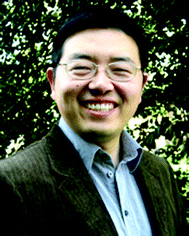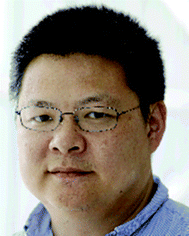Supramolecular medicine
Honggang
Cui
 *abc and
Bing
Xu
*abc and
Bing
Xu
 *d
*d
aDepartment of Chemical and Biomolecular Engineering, Department of Materials Science and Engineering, and Institute for NanoBiotechnology, The Johns Hopkins University, 3400 N Charles Street, Baltimore, MD 21218, USA. E-mail: hcui6@jhu.edu
bDepartment of Oncology and Sidney Kimmel Comprehensive Cancer Center, Johns Hopkins University School of Medicine, Baltimore, MD 21205, USA
cCenter for Nanomedicine, The Wilmer Eye Institute, Johns Hopkins University School of Medicine, 400 North Broadway, Baltimore, MD 21231, USA
dDepartment of Chemistry, Brandeis University, 415 South Street, Waltham, MA 02453, USA. E-mail: bxu@brandeis.edu
Supramolecular chemistry has its roots in biology and medicine. The fundamental principles of host–guest chemistry can be traced to the “lock and key” interactions between enzymes and substrates. In medicine, almost all drug–receptor interactions are supramolecular in nature. The convergence of supramolecular chemistry and medicine has prompted the development of supramolecular medicine, an area focusing on the utilization of supramolecular chemistry/molecular assembly as a means to improve the practice of medicine. In a broader context, Supramolecular Medicine can be defined as the supramolecular formulation of diagnostic and therapeutic agents for the diagnosis, treatment, and prevention of disease. On the supramolecular side, our fabrication strategies have progressed from the creation of thermodynamically stable structures to kinetically trapped and far-from-equilibrium architectures, and more recently to dynamic, adaptive materials with spatiotemporally responsive features. The unique and often advantageous properties of supramolecular materials have led to extensive exploration of their use in the fields of drug delivery, disease diagnosis and imaging, and regenerative medicine. On the medicine side, the emergence of nanostructure-based drug delivery systems has provided a new means for optimizing drugs’ pharmacokinetic profiles for more effective therapies, and also new momentum for developing innovative strategies with which to battle cancer and other incurable diseases. Although much progress has been made, the lack of clinical approval of carrier-based nanomedicines underscores the challenges facing the field. Can supramolecular chemistry and molecular assembly provide the next push in the development of improved therapeutics and diagnostics? This themed issue on Supramolecular Medicine has assembled a list of leading researchers to review the recent progress in utilizing supramolecular strategies to address emergent issues in health and disease, and to share their visions for future research directions in supramolecular design and non-covalent synthesis, as well as their related biomedical applications.
Recognizing the potential of supramolecular design in drug delivery, Webber and Langer review the benefits, strategies, and opportunities of using supramolecular chemistry (i.e., specific, dynamic, and tunable non-covalent interactions) to improve the precision and effectiveness of pharmaceutical practice (DOI: 10.1039/C7CS00391A). They outline a variety of ways in which supramolecular design can be incorporated within a drug delivery system, highlighting the opportunities that exist for various supramolecular strategies to improve the practice of medicine. Finally, they provide an optimistic perspective on the continued emergence of new and improved therapeutics rooted in these design principles.
Multivalent interactions are essential for molecular adhesion in many biological processes. Synthetic mimicry of these noncovalent yet strongly adhesive interactions through multiple binding is a promising strategy for developing novel therapeutics. Aida, Okuro and coworkers illustrate how supramolecular chemistry can be harnessed to develop “molecular glues” that allow the modulation of biomolecular functions (DOI: 10.1039/C7CS00647K). They review the molecular design strategies for adhesive motifs and highlight the guanidinium ion-based salt-bridge as a key interaction for biomolecular adhesion. The applications of molecular glues are also discussed, from manipulation of biomolecular assemblies and drug delivery systems, to the modulation of biomolecular functions. Looking forward, the Aida team suggests that the adhesion selectivity, spatiotemporal control of the adhesivity, and the stability of the molecular glue complexes are important factors to consider for future therapeutic and other practical applications.
To mimic the complex and dynamic nature of the extracellular matrix (ECM) for tissue engineering and regenerative medicine, it has become increasingly evident that many targeted tissues require matrices that not only capture key features of the ECM, but that the cell-laden scaffolds can be modulated in a spatiotemporal fashion. By focusing on the use of photochemical reactions to create dynamic hydrogel environments to direct cell behavior, Brown and Anseth assess the approaches that generate spatiotemporal hydrogel biomaterials for regenerative medicine (DOI: 10.1039/C7CS00445A). They present a comprehensive overview of the reactions used to form, functionalize, reshape, and degrade cell-laden hydrogels, and conclude that despite important progress the field of regenerative medicine is still at its early stage of development. The future development of spatiotemporal hydrogels can benefit from the advancements in click chemistry, bio-orthogonal chemistry, and photochemistry, and by interfacing with advanced manufacturing techniques such as stereolithography.
Supramolecular chemistry can provide new capabilities, especially dynamics, for synthetic biomaterials. In this vein, Dankers, Meijer and coworkers discuss the development of synthetic supramolecular biomaterials that can mechanically, structurally, and functionally emulate the key features of tissues or ECM (DOI: 10.1039/C7CS00564D). They expound on the guiding principles for constructing multi-component supramolecular biomaterials, with a focus on the translation of one-dimensional supramolecular polymers into dynamic, adaptive, and biologically active materials for regenerative medicine. In their view, the synthetic fibrous supramolecular structures can be developed into two classes of biomaterials: thermoplastic elastomers for in situ engineering of load-bearing tissues, or hydrogels as artificial matrices for stem cell and organoid expansion in vitro. Given the importance of introducing a feedback–response mechanism in biomaterials design and also to meet nature's complexity using supramolecular fibrous assemblies, they envision that it is essential to consider both the natural processes of cells creating their own niche via secretion of ECM molecules, and the synthetic means to recapitulate ECMs using a great diversity of bioactive, self-assembling entities.
Synthetic polypeptides represent an important class of biomaterial building units. Cheng and coworkers summarize the recent development of polypeptide-based supramolecular nanostructures for gene delivery, drug delivery, bio-imaging, tissue engineering, and for use as antimicrobial agents (DOI: 10.1039/C7CS00460E). They highlight the recent progress in the chemical design of functional polypeptides with the goal of manipulating their assembly behavior and optimizing their biomedical performance. To use synthetic polypeptides as a broader biomaterials platform, future research directions, in their opinion, should focus upon improving control over their hierarchically-ordered structures across multiple length scales, a deeper understanding of the structure–property–function relationships, and more cost-effective synthesis and purification procedures.
Biologic peptides offer enormous potential as both therapeutics and molecular tools. Tirrell and coworkers review the use of self-assembled vehicles to deliver therapeutic peptides (DOI: 10.1039/C7CS00536A). First introducing the biological roles of therapeutic peptides as protein–protein interaction (PPI) modulators, binding components, signal promoters, and essential inhibitors for biological events, they then provide a thorough overview of the variety of molecular engineering strategies exploited thus far, aiming to overcome the biological barriers related to the absorption, distribution, metabolism, and excretion (ADMEs) of peptide therapeutics. At the end, the Tirrell team highlights two important challenges: targeted delivery to the brain and oral delivery of therapeutic peptides. A fundamental understanding of structure–property relationships between peptides and their delivery vehicles is critical to address these challenges.
The development of successful medicine has to begin with the understanding of diseases, as painfully reminded by the countless failures of drug candidates for treating neurodegenerative diseases, such as Alzheimer's disease. Mezzenga and coworkers illustrate the implications of peptide assemblies in amyloid diseases (DOI: 10.1039/C7CS00372B). By focusing on the self-assembled structures of aberrant peptides or proteins, the authors highlight the crucial role that molecular self-assembly plays in the toxicities of the amyloids. Such correlation may help us understand the structure–function–toxicity relationship, an urgently needed tool for detecting and treating amyloid diseases.
Although the molecular mechanism of cancer is much better understood than neurodegenerative diseases, there are unmet needs for the early diagnosis and effective treatment of cancer. After discussing the clinically-relevant advantages and challenges arising from the incorporation of porphyrins within supramolecular platforms, Zheng and coworkers describe a series of seminal and cutting-edge in vivo studies that employ porphyrins as a supramolecular platform for developing innovative theranostic approaches, enabling a synergistic combination of photodynamic therapy and photothermal, chemo, gene or immune therapy for potential cancer treatment (DOI: 10.1039/C7CS00525C).
Due to the emergent properties of molecular assemblies, which are able to form via instructed assembly processes in vivo, the path to form assemblies and the dynamic to disassemble are important aspects of supramolecular chemistry for applications in developing novel therapeutic strategies. Xu and coworkers discuss the development of supramolecular catalysis and dynamic assemblies for medicine (DOI: 10.1039/C7CS00472A) in the context of molecular imaging and anticancer therapeutics. In their view, knowledge generated in structural biology can serve as an inspiration for the design of molecular assemblies as novel therapeutics, particularly for cancer therapy and neurodegenerative diseases. Spatiotemporal control and precise regulation of assembly/disassembly in living organisms are regarded as important challenges for developing next generation biomaterials with precisely controlled functions.
Molecular assembly can be used to create self-formulating drugs. The self-assembly of therapeutic agents into well-defined supramolecular nanostructures is an emerging concept in both fields of molecular assembly and drug delivery to obtain one-component nanomedicines of high reproducibility. In this context, Cui and coworkers review the design and synthesis strategies of various types of self-assembling prodrugs (SAPDs) (DOI: 10.1039/C7CS00521K). Self-assembling prodrugs as a whole represent a new paradigm in drug delivery as the modified drugs essentially become single-component medicines that are self-delivering and self-formulating. According to Cui and his team, there exist two broad classes of SAPDs, defined by their molecular nature—macromolecular and small molecule. Macromolecular SAPDs are polymeric systems formed by the conjugation of multiple drugs to a polymer of synthetic or biological origin. Small molecule SAPDs, on the other hand, comprise a discrete number of drug molecules connected to a single promoiety to create a homogeneous conjugate (monodisperse in molecular weight). The authors provide an overview of the guiding principles in the molecular design of each prodrug group, and offer their perspective on the future development of the field with respect to clinical translation.
In summary, we are very grateful to all the contributors for their efforts, insights, and visions of the field of supramolecular medicine, and hope this issue will provide perspectives on the challenges and promises of using supramolecular chemistry to address specific medical issues, and stimulate further research into the area.
| This journal is © The Royal Society of Chemistry 2017 |


